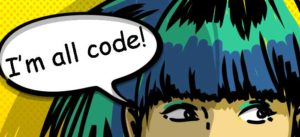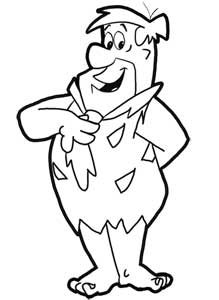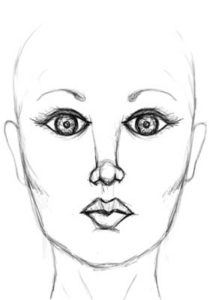 I’ve already waxed poetic about code in this blog, specifically how a circle in an abstract painting is often code for a face, how a horizontal line is often code for a landscape (they don’t call those lines HORIZON-tal fer nuthin’). But I want to explore the subject a little more, go a little deeper.
I’ve already waxed poetic about code in this blog, specifically how a circle in an abstract painting is often code for a face, how a horizontal line is often code for a landscape (they don’t call those lines HORIZON-tal fer nuthin’). But I want to explore the subject a little more, go a little deeper.
 When we start to draw – usually around age 3 or something – we learn to take a 3 dimensional object in the real world and reduce it down to a flat, 2 dimensional symbol that represents the object on a piece of paper. It is a very sophisticated piece of mental gymnastics! And the gymnasium is located deep within the subconscious. Learning to draw is not a conscious process; it is an unconscious opening of some genetic yearning that exists in all human children.
When we start to draw – usually around age 3 or something – we learn to take a 3 dimensional object in the real world and reduce it down to a flat, 2 dimensional symbol that represents the object on a piece of paper. It is a very sophisticated piece of mental gymnastics! And the gymnasium is located deep within the subconscious. Learning to draw is not a conscious process; it is an unconscious opening of some genetic yearning that exists in all human children.
The tree is reduced to a circle resting on a rectangle. The house is a square with a triangle on top. People are a collection of shapes, none of which occur in real people.
What we are actually learning is how to code. And we usually get heaps of positive reinforcement for it! Mommy and Daddy tape the flat result to the refrigerator and gush over it whenever anyone comes by.
As we grow, so does our ability to code. We learn that a circle within an squashed oval is an eye, that a rounded S shape can be an eyebrow and a nose. I remember learning to draw Fred Flintstone in fourth grade. It was a brilliant collection of easy code that anyone could master in five minutes or less.
an eyebrow and a nose. I remember learning to draw Fred Flintstone in fourth grade. It was a brilliant collection of easy code that anyone could master in five minutes or less.
It is about this time that the artistic impulse – the natural inclination we all have to reduce the real world down to code – is killed in most of us. Someone comes along who does a much better job expressing the code on the paper, receives copious praise from teachers and classmates, and we decide (since we aren’t able to do what they’re doing) we can’t draw. On to Little League, fashion and cars.
Those who continue to draw, continue to develop. As adults, we learn to take that flat, 2 dimensional, symbolic code and create the illusion of 3 dimensions through shading and perspective. This coding can become breathtaking, even valuable. But for many who do art, it’s still CODE . . . just good code.
 When I look at art, especially realistic art, I look for code. Is that what an eye really looks like? Or is this an adult’s version of the squashed oval with a circle inside? I know that coding tends to simplify and impose an artificial structure to what the eye sees . . . is the perspective in this landscape correct? Does the lighting make sense? And yes, I usually prefer less code to more. Usually . . .
When I look at art, especially realistic art, I look for code. Is that what an eye really looks like? Or is this an adult’s version of the squashed oval with a circle inside? I know that coding tends to simplify and impose an artificial structure to what the eye sees . . . is the perspective in this landscape correct? Does the lighting make sense? And yes, I usually prefer less code to more. Usually . . .
But then you have Picasso and Haring and gosh, dozens of others who very consciously built work from code and made no attempt to mask it. And the work is remarkable!
Ultimately, I think it comes down to intention. If you are intending to make a statement by reducing the real world down to sophisticated code, that’s great! If you’re intending to do a faithful portrait and revert to code . . . not so much!
If you’ve taken a drawing class in the last 40 years, you probably did exercises designed to get you ‘out-of-your-head.’ Drawing on the Right Side of the Brain is a book and method designed to do that. You draw objects upside down, you draw without looking at the paper, you draw with your non-dominant hand. The exercises force you to abandon code and focus on what the eye really sees: line, shape, positive and negative space. And it works. The results are often stunning!
In my own work, coding takes place when I start finding things, then developing them in my pieces. It’s almost always a disaster! My painting intent is to apply pigment  and line spontaneously and without intention. When I start making things on the canvas, I rocket right back into my head, reverting to my own brand of code. Intention takes over and the result is always dead on arrival and . . . dishonest. That’s when the gesso comes out!
and line spontaneously and without intention. When I start making things on the canvas, I rocket right back into my head, reverting to my own brand of code. Intention takes over and the result is always dead on arrival and . . . dishonest. That’s when the gesso comes out!
I don’t have a sharp ending for this post, no conclusion to draw. It’s more a reminder for myself. But this comes to mind:
Coding doesn’t just take place in art. It’s all around us; and we have to be careful. Sometimes the coding is so powerful that we begin to take it for reality, begin to compare our real selves against the idealized code that has been created. Consider Barbie. There is not a female human on the planet that has her figure, her dimensions . . . not without a whole lot of surgery. Yet we’ve held this ridiculous piece of plastic code up to little girls for decades and said, ‘Isn’t Barbie pretty!’ Coding can be destructive.